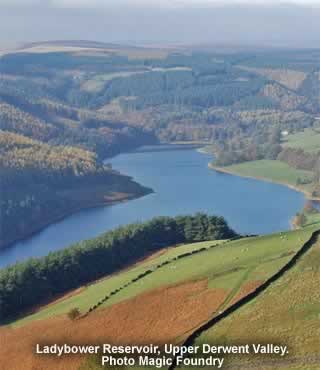Upper Derwent Valley |
|
 |
|||
Britain > Peak District > Upper Derwent Valley |
||
Three consecutive dams forming three consecutive reservoirs |
||
The River Derwent is one of the many waterways in the Peak District. At the start of its 80 kilometre journey it passes through the Upper Derwent Valley, which is deep, and has plenty of rainfall. Around the beginning of the 20th Century the government decided that this was a perfect place to build dams, and thus create reservoirs. These were essential for supplying the steadily increasing water demands of a growing population. |
||
Before long, work had begun. 3 dams were constructed, resulting in 3 separate reservoirs. Howden Dam was first, with Derwent Dam coming soon afterwards. They were huge, ambitious projects, which took years to finish. The many hundreds of workers were housed in a temporary town called Birchinlee. The settlement was nicknamed "Tin Town", as most of the rudimentary huts were made from this cheap metal. Despite using such elementary building materials, Tin Town had everything from a hospital to a police station. Most of these structures have been removed, but there are still a few remnants. |
||
Construction of the final dam, Ladybower, was begun in 1935. It was to be the biggest reservoir in Britain, supplying much-needed water to the cities of the Midlands. Even so, the project had attracted some sharp criticism. The new reservoir would completely flood the two villages of Ashopton and Derwent. The graves of Derwent church had to be moved. In later years, when the water levels were low, its spire, left as a memorial, would poke unnervingly out of the surface. It was finally dynamited in 1947 for safety reasons. |
||
Work on Ladybower Dam continued throughout World War II, despite it being incredibly tricky to find workers and building materials. It was finally completed in 1943, but it took another two years for the reservoir to fill up. After it did, the Upper Derwent valley became the largest area of open water in the Peak District, with a capacity of over 450,000 million litres. |
||
While Howden, Derwent and Ladybower reservoirs were created for purely practical reasons, they still happen to form a wonderfully beautiful landscape. The area is crammed full of greenery and wildlife, and it has become exceedingly popular with walkers, cyclists and fishermen. |
||
The three reservoirs each have their own distinct highlights. Howden's landmark is the Slippery Stones bridge, built in the 17th century to carry packhorses. This bridge was originally located in Derwent Village to the south but was moved when the reservoirs were created. Each stone was carefully extracted and numbered, so it could be put back together exactly as it was before. |
||
Derwent Dam is the most famous of the three, thanks to the part it played in the Second World War. It played a key part in preparation for the famous Dambusters mission, where a group of skilled pilots bombed the Ruhr valley dams in Germany. Derwent was identified as being similar to these enemy structures, so it was used for practice runs. The RAF came here to rehearse their delicate mission, which required extremely skilful low flying. The pilots also tested their new weapons - the infamous bouncing bombs. These state-of-the-art explosives would skim along the water like a stone, before reaching their target. The west tower of the Derwent Dam contains a museum dedicated to the Dambusters and their mission. It includes plenty of photographs and memorabilia, as well as an example of a real bouncing bomb. |
||
The Ladybower area was also used by World War II pilots, even before the dam was completed. The surrounding land is scattered with the remains of crashed aircraft. On dark nights, some locals have reported seeing eerie lights in the sky. They swear blind that these are the ghosts of the broken aeroplanes, flying above Ladybower once more. |
||
|
||
Derwent Cycle Hire is open daily (weekends only in Winter), from 10:00am to 5:30pm (or dusk). Hire costs around £12 per bike. Fairholmes Car Park, Derwent, Bamford, Sheffield S33 0AQ. Tel: 01433 651261 |
||
|
Pocket Britain is optimised for use on a smartphone or tablet with internet access. All content is subject to copyright. All reasonable methods have been used to ensure information supplied is accurate at the time of publication. However, it is advisable to check information before relying on it. Privacy Policy |